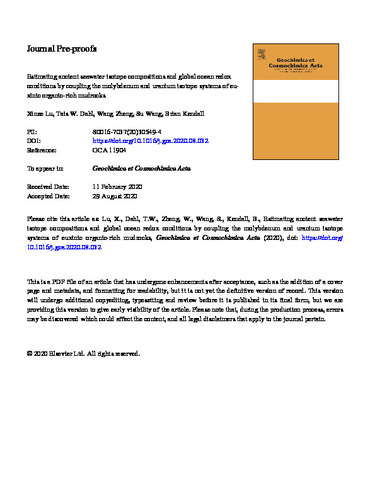| dc.contributor.author | Lu, Xinze | |
| dc.contributor.author | Dahl, Tais W. | |
| dc.contributor.author | Zheng, Wang | |
| dc.contributor.author | Wang, Su | |
| dc.contributor.author | Kendall, Brian | |
| dc.date.accessioned | 2023-10-26 18:06:11 (GMT) | |
| dc.date.available | 2023-10-26 18:06:11 (GMT) | |
| dc.date.issued | 2020-12-01 | |
| dc.identifier.uri | https://doi.org/10.1016/j.gca.2020.08.032 | |
| dc.identifier.uri | http://hdl.handle.net/10012/20067 | |
| dc.description | The final publication is available at Elsevier via https://doi.org/10.1016/j.gca.2020.08.032. © 2020. This manuscript version is made available under the CC-BY-NC-ND 4.0 license http://creativecommons.org/licenses/by-nc-nd/4.0/ | en |
| dc.description.abstract | The sedimentary Mo and U isotope systems have been commonly used as novel global ocean redox tracers due to their
long oceanic residence times and redox-sensitive behavior. However, local sedimentary environments and global ocean redox
conditions both influence the Mo and U isotope compositions of euxinic organic-rich mudrocks (ORM). Here, we further
develop the coupled use of Mo and U isotope data from euxinic ORM to more robustly infer coeval global ocean redox conditions.
We measured ẟ238U from eight late Neoproterozoic to middle Paleozoic ORM units that have previously reported Mo
isotope and Fe speciation data. Integration of our new data with previously published Proterozoic and Phanerozoic Mo and
U isotope data reveals that there is no overall correlation between the Mo and U isotope compositions of euxinic ORM. This
observation confirms that the extent to which local versus global environments influenced the preserved Mo and U isotope
compositions in ORM was variable. Individual ORM units can have negative, positive, or no correlation between ẟ98Mo
and ẟ238U. A negative correlation between ẟ98Mo and ẟ238U in the Upper Devonian Kettle Point Formation is similar to
the observations from modern euxinic basins, reflecting a major control on the Mo-U isotope systematics by changes in
the local depositional environment, such as bottom-water sulfide concentrations. A positive correlation between ẟ98Mo
and ẟ238U observed in the Upper Ordovician Fjacka Shale is best explained by changes in global ocean redox conditions that
simultaneously shifted the Mo and U isotope compositions of the global seawater and the Fjacka Shale ORMs in the same
direction. No correlations between ẟ98Mo and ẟ238U for euxinic ORM may be caused by specific local depositional changes, a
lack of or a combination of local and global environmental changes, and/or is an artifact of limited data. For example, a vertical
trend (variable ẟ98Mo but similar ẟ238U) is shown by most samples from Member IV of the Ediacaran Doushantuo Formation,
implying a strong influence on the Mo isotope data by an Fe-Mn particulate shuttle. A horizontal trend (similar
ẟ98Mo but variable ẟ238U) is observed from the Paleoproterozoic Zaonega Formation, implying that relatively constant bottom
water sulfide concentrations caused similar magnitudes of Mo isotope fractionations whereas other factors (e.g., U reduction
pathways, aqueous U species, productivity) were responsible for variable U isotope fractionations. Relatively constant
elemental concentrations and isotope compositions from the Tanezzuft Formation are indicative of stable conditions at local
and global scales. We further propose a method to estimate the coeval seawater Mo and U isotope compositions based on a
coupled Mo-U isotope mass balance model and the observations from modern euxinic basins. The coupled Mo-U isotope data from euxinic ORMs provide more insights on the local and global environmental controls on the preservation of both
isotope systems than previously realized. Our study highlights the importance of examining the local depositional environment
and using large datasets of coupled Mo-U isotope compositions from euxinic ORM intervals to reconstruct paleocean
redox conditions. | en |
| dc.language.iso | en | en |
| dc.publisher | Elsevier | en |
| dc.relation.ispartofseries | Geochimica et Cosmochimica Acta;290 | |
| dc.subject | depositional environment | en |
| dc.subject | paleoredox proxy | en |
| dc.subject | mass balance model | en |
| dc.title | Estimating ancient seawater isotope compositions and global ocean redox conditions by coupling the molybdenum and uranium isotope systems of euxinic organic-rich mudrocks | en |
| dc.type | Article | en |
| dcterms.bibliographicCitation | Lu, X., Dahl, T. W., Zheng, W., Wang, S., & Kendall, B. (2020). Estimating ancient seawater isotope compositions and global ocean redox conditions by coupling the molybdenum and uranium isotope systems of Euxinic Organic-rich mudrocks. Geochimica et Cosmochimica Acta, 290, 76–103. https://doi.org/10.1016/j.gca.2020.08.032 | en |
| uws.contributor.affiliation1 | Faculty of Science | en |
| uws.contributor.affiliation2 | Earth and Environmental Sciences | en |
| uws.typeOfResource | Text | en |
| uws.peerReviewStatus | Reviewed | en |
| uws.scholarLevel | Faculty | en |

